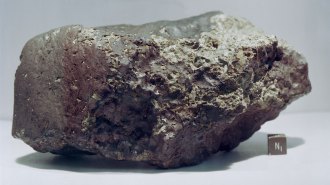Search Results
Studying the brain 101
Students will be introduced to neuroscience by learning about nerve anatomy and physiology, and they will research different methods of studying the brain.
Learning Outcomes: Develop an understanding of how scientists approach the study of the brain.
Form fits function in extreme environments
From buildings to machines to household objects — and even in the natural world — the structure of something relates to its function. Sea urchin skeletons, for example, have a recurring geometric design called a Voronoi pattern that also shows up in honeycombs and dragonfly wings. The pattern probably strengthens the skeleton and could inspire the creation of strong, lightweight materials. In this activity, students will explore aspects of structure and function in everyday objects before applying the same concepts to the natural patterns found in sea urchin skeletons. Inspired by the sea urchin, students can use an engineering design process to brainstorm solutions to real-world problems.
Making sense of animal worlds
In this activity, students will discuss how literary devices can be used to convey scientific concepts, research how an animal of their choice senses the world and compose a piece of creative writing based on what they find.
Rates and what affects them
Students will define rates and their units of measurement for biological and chemical processes before discussing factors that affect rates.
Octopus moms seek the heat
Students will answer questions about the Science News article “Some deep-sea octopuses aren’t the long-haul moms scientists thought they were,” which describes how octopuses laying eggs in warm waters near geothermal springs speed up hatching. A version of the article, “Deep-sea ‘octomoms’ seek the heat,” appears in the April 9, 2022 issue of Science News.
Evaluating scientific claims with new evidence
Students will compare two Science News articles and analyze how new evidence has revised an initial claim and the reasoning behind that claim. As a bonus, students can answer chemistry questions about abiotic and biotic reactions.

Chemistry that’s out of this world
Students will answer questions about the online Science News article “Organic molecules in an ancient Mars meteorite formed via geology, not alien life,” which describes new research into the origin of organic material found in a space rock. A version of the article, “Meteorite’s organics aren’t signs of life,” appears in the February 12, 2022 issue of Science News.
Cycling through an ecosystem
Students will discuss nutrient cycling and conservation of matter, and how these concepts can be observed in an ecosystem.
Rethinking whale appetites
Students will answer questions about the online Science News article “Baleen whales eat (and poop) a lot more than we realized,” which details scientists’ efforts to accurately estimate how much certain whale species eat and what that means for ecosystems. A version of the article, “Whales eat more than we thought,” appears in the December 4, 2021 issue of Science News.
Mighty mitochondria
Students will answer basic questions about cell structure and energy production, draw diagrams to visualize how mitochondria in sea otters may function differently than in other marine mammals and brainstorm a research question for further investigation.
Sea otters’ cellular surprise
Students will answer questions about the online Science News article “Sea otters stay warm thanks to leaky mitochondria in their muscles,” which explores scientists’ efforts to figure out how the ocean’s smallest mammal maintains an extreme metabolism. A version of the story, “How muscles keep otters warm,” appears in the August 14, 2021 issue of Science News.
Speaking of science
Students will investigate animals that regenerate, discuss how energy plays a role in the process and think about why scientists might be interested in studying animal regeneration. Students will use what they’ve learned to write a script and narrate a Science News video of regenerating sea slugs.